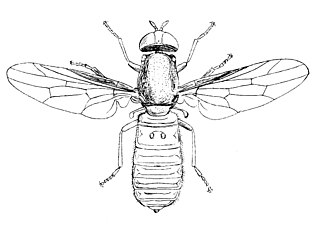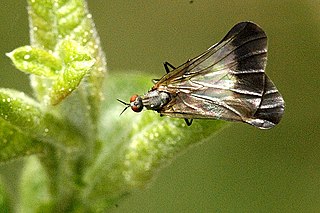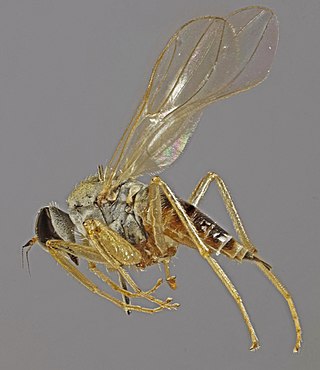
Empididae is a family of flies with over 3,000 described species occurring worldwide in all the biogeographic realms but the majority are found in the Holarctic. They are mainly predatory flies like most of their relatives in the Empidoidea, and exhibit a wide range of forms but are generally small to medium-sized, non-metallic and rather bristly.

The Scenopinidae or window flies are a small family of flies (Diptera), distributed worldwide. In buildings, they are often taken at windows, hence the common name window flies.

Hybotidae, the typical dance flies, are a family of true flies. They belong to the superfamily Empidoidea and were formerly included in the Empididae as a subfamily.

Tachydromia is a genus of hybotid flies. It is widespread around the world, with species found essentially everywhere except the polar regions and some remote islands. They are not very diverse in East and Southeast Asia, or in Africa

Empis is a genus of dance fly found in the fly family Empididae.

Rhamphomyia is a genus of dance flies, in the fly family Empididae. It contains more than 600 species in 8 subgenera.

Tachydromiinae is a subfamily of hybotid flies widespread in the world.

Ocydromia is a genus of flies in the family Hybotidae.
Milan Chvála was a Czech entomologist who specialised in Diptera.

Hybos is a genus of hybotid flies.

Hemerodromiinae are a worldwide group of predatory flies with raptorial forelegs.

Empidinae, also called dance flies, are a subfamily of empidoid flies. They are mainly predatory flies like most of their relatives, and generally small to medium-sized. Most species are flower visitors and they can be effective pollinators.

Platypalpus candicans is a species of fly in the family Hybotidae. It is found in the Palearctic.
Platypalpus impexus is a species of hybotid dance fly in the family Hybotidae.
Platypalpus tersus is a species of hybotid dance flies.
Platypalpus melleus is a species of hybotid dance flies.
Wiedemannia is a genus of flies in the family Empididae.

Oedalea is a genus of flies in the family Hybotidae.











